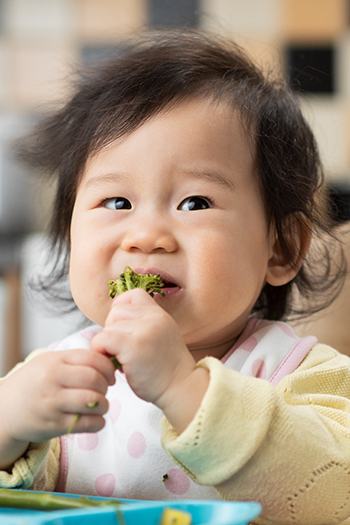
Baby's First Bites: Is Baby-led Weaning Right for Your Little One?
How would you like to skip the phase of baby food jars and spoon feeding baby like it's a flying airplane coming to land? Now, more and more parents are deciding to sidestep this way of introducing baby's first solids with an alternative method known as baby-led weaning, a practice that has been popular in the UK, Australia and New Zealand for years.
While Americans tend to think of “weaning” as ending breastfeeding, many other countries refer to this term for the introduction of complimentary foods. As the name implies, baby-led weaning is the practice of letting baby take control during the introduction of solids by letting baby feed herself rather than parents spoon feeding when it's time to eat.
Those in favor of baby-led weaning suggest benefits similar to those of breastfeeding, where baby is able to self-regulate how much she eats and stop when she feels full. It also gives baby a chance to experience more tastes and textures than when simply offered traditional first foods, improve hand-eye coordination and fine tune motor skill development.
To initiate solids using this method, first talk with baby's pediatrician to ensure baby-led weaning is right for your family. Baby should be about 6 months old and show signs of readiness. She should be able to sit up on her own; be ready and able to chew; pick up items with her thumb and forefinger; show signs of interest in food and mealtimes; and should have lost the tongue-thrust reflex (where baby pushes solids out of the front of the mouth.)
Once ready to begin feedings, sit baby upright and serve larger pieces of food that are easy for baby to pick up on her own and mouth – such as thick strips or sticks rather than bite-sized pieces. Opting to serve foods that are part of your own meal (but without added “adult” seasonings like salt and sugar) are preferred when possible, such as cooked vegetables and pasta, potato, toast, flaky fish and scrambled eggs. Avoid any foods that may pose a choking hazard such as peanuts, popcorn, raw vegetables and whole grapes – and always watch baby while she is eating.
During this process, remember it is simply a time of messy and fun exploration for your little one and avoid getting caught up thinking baby has to clear her plate for it to be successful. For the first year of life, baby's primary source of nutrition will continue to be breastmilk or formula rather than solid foods.
For more information on baby-led weaning, visit www.borntoeatbook.com or http://www.babyledweaning.com or speak to your child's pediatrician.


